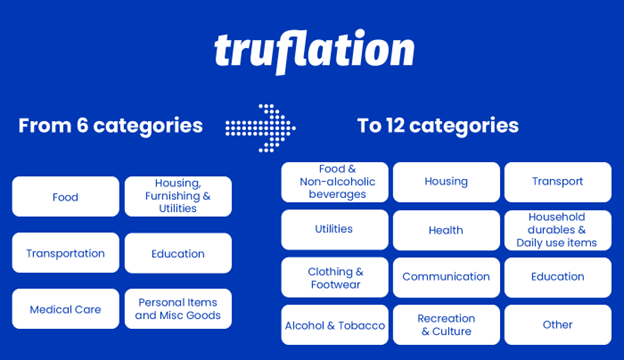Truflation’s newly revamped dashboard provides data on 12 key cost categories to more accurately measure inflation rates as compared to many government consumer price indicators
Truflation, a decentralized, blockchain-based inflation index initiative, has announced the release of a new and redesigned UI for its dashboard, complete with a new set of features, functions, and capabilities. This new “Dashboard 2.0” revises the six standard expenditure categories used by many official government consumer price indexes (CPIs) and adds six new categories as well, bringing the total number of cost categories covered by the platform to 12.
With this new update, Truflation hopes to significantly improve the accuracy and relevance of inflation data that is available to private and public markets and enterprises. Truflation has also revised the respective weights of each cost category to more accurately reflect changing tastes, trends, and macroeconomic movements that affect consumer spending behavior.
The release of Dashboard 2.0 is a major development that takes Truflation away from the current CPI model which uses only six cost categories to cover all areas of consumer spending. By breaking up these major cost categories, revising the weights of each category, and adding new categories that are relevant to today’s consumers, Truflation hopes to provide users with better and deeper data insights, more comprehensive and accurate breakdowns of price changes, and independent assessments of price action in the categories that matter most to people and businesses – all securely and transparently stored and provisioned to users via the blockchain.
Stefan Rust, the Founder of Truflation, commented on the new update by saying: “The release of Dashboard 2.0 will represent a huge leap for Truflation. Our goal is to provide the best economic insights possible to users all around the world. With independent demographic data, more relevant cost categories, and real-time data feeds from a wide range of reliable providers, we can provide direct and accurate information on what households actually spend money on. We can also measure inflation more accurately. This information can then be used for everything from procurement to supply chain optimization to resource planning, marketing, pricing, and more. We are excited about expanding into new markets and bringing this value-added service to people and businesses operating in a wide range of different industries.”
Mr. Rust is a former CEO of Bitcoin.com and has an exceptionally talented team with over five decades of data science experience working on Truflation. The team recently acquired a vast data trove on global household expenditure data. This data will be used to build Truflation’s index of what households actually buy and spend money on throughout the year. Since Truflation can update data weights in real-time based on newer data, it can accurately calculate inflation rates for different geographic areas and provide deeper insight into the 12 key cost categories of consumer spending.
Thanks to standardization and seamless integration with data feeds, Truflation’s indices can be easily scaled and rolled out across different countries, markets, and geographies using the same reliable methodology. Cost categories and basket weights can also be adjusted and updated over time to improve both the accuracy of results and comparability across different regions and time periods. This level of flexibility and relevance is in contrast with many current systems that use non-standard approaches to calculating inflation rates, which makes comparisons and analysis harder to perform.
At present, Truflation uses consumer data for multiple household income levels and uses census, mini-census, and consumer and merchant surveys for price information, which makes Truflation’s empirical data not only very granular but highly comprehensive as well.







